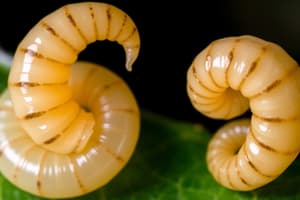Podcast
Questions and Answers
Albendazole is the drug of choice for the treatment of ______.
Albendazole is the drug of choice for the treatment of ______.
Trichinosis
To prevent Trichinosis, discouraging people from eating raw ______ is essential.
To prevent Trichinosis, discouraging people from eating raw ______ is essential.
fish
Humans become infected with Trichinella spiralis by eating raw or poorly cooked ______ flesh.
Humans become infected with Trichinella spiralis by eating raw or poorly cooked ______ flesh.
mammal
The average lifespan of a larva can range from ______ to 10 years, and may even reach up to 40.
The average lifespan of a larva can range from ______ to 10 years, and may even reach up to 40.
Trichinella spiralis is primarily transmitted from animal to animal among ______ and omnivores.
Trichinella spiralis is primarily transmitted from animal to animal among ______ and omnivores.
The larvae of Trichinella spiralis can migrate to different parts of the body and form ______.
The larvae of Trichinella spiralis can migrate to different parts of the body and form ______.
Good sanitary practices and treatment of all infected ______ are crucial for prevention.
Good sanitary practices and treatment of all infected ______ are crucial for prevention.
Information dissemination and educational programs are particularly important in ______ areas.
Information dissemination and educational programs are particularly important in ______ areas.
Diagnosis involves finding the characteristic eggs in the ______.
Diagnosis involves finding the characteristic eggs in the ______.
Common symptoms include abdominal pain, diarrhea, and ______.
Common symptoms include abdominal pain, diarrhea, and ______.
The mode of infection is through the consumption of raw fresh water ______.
The mode of infection is through the consumption of raw fresh water ______.
Treatment options include a high protein diet and ______ replacement.
Treatment options include a high protein diet and ______ replacement.
Severe pathology can lead to ______ loss and metabolic imbalance.
Severe pathology can lead to ______ loss and metabolic imbalance.
Cases of the disease have been reported in Thailand and isolated cases from ______ and Egypt.
Cases of the disease have been reported in Thailand and isolated cases from ______ and Egypt.
Mebendazole is prescribed at a dosage of ______ mg.b.i.d.for 20 days.
Mebendazole is prescribed at a dosage of ______ mg.b.i.d.for 20 days.
Severe malabsorption of fats and sugars can lead to ______ or body wasting.
Severe malabsorption of fats and sugars can lead to ______ or body wasting.
Parasitic zoonosis refers to diseases and infections which are naturally transmitted between vertebrate animals and ______.
Parasitic zoonosis refers to diseases and infections which are naturally transmitted between vertebrate animals and ______.
Capillaria philippinensis is characterized by abdominal pain, chronic diarrhea, and ______ stomach.
Capillaria philippinensis is characterized by abdominal pain, chronic diarrhea, and ______ stomach.
The adult worms of C. philippinensis are embedded in the mucosa of the upper small ______ of human host.
The adult worms of C. philippinensis are embedded in the mucosa of the upper small ______ of human host.
The eggs of C. philippinensis may embryonate in soil or ______.
The eggs of C. philippinensis may embryonate in soil or ______.
When infected fish is eaten by suitable vertebrates, including humans, the larvae develop into adult worms and start producing ______ in 2 weeks.
When infected fish is eaten by suitable vertebrates, including humans, the larvae develop into adult worms and start producing ______ in 2 weeks.
C. philippinensis has a peanut-shaped egg with a ______ shell.
C. philippinensis has a peanut-shaped egg with a ______ shell.
The intestinal capillariasis is also known as a ______ disease.
The intestinal capillariasis is also known as a ______ disease.
In the life cycle of C. philippinensis, the eggs hatch in the small intestines of fresh water ______.
In the life cycle of C. philippinensis, the eggs hatch in the small intestines of fresh water ______.
Study Notes
Trichinella spiralis
- Most significant species causing trichinosis; others include T. britovi, T. nativa, T. murrelli, T. nelsoni, T. papuae, and T. pseudospiralis.
- Adult worms primarily inhabit animals' small intestines, while larvae have a spear-like tip enabling them to burrow into tissues.
- Transmission to humans occurs through the consumption of raw or undercooked pork and other mammals.
Life Cycle of Trichinella
- Adults reproduce in animal intestines, releasing larvae that penetrate the intestinal mucosa and encyst in skeletal muscle.
- Human infection arises from ingesting encysted larvae in contaminated meat.
- Larvae mature in the human small intestine, leading to mating and further production of larvae.
Pathology and Symptoms
- Symptoms include abdominal pain, diarrhea, weight loss, anorexia, and edema caused by protein loss.
- Severe cases can lead to malabsorption, electrolyte imbalance, and potentially fatal outcomes if untreated.
Diagnosis
- Characteristic eggs can be identified in feces, alongside possible larvae and adult worms.
- Stool examination methods include direct smear and concentration techniques, with recovery possible from duodenal aspiration.
Treatment
- Recovery includes a high-protein diet and electrolyte replenishment.
- Medications like Mebendazole and Albendazole are administered; Albendazole at 400 mg for 10 days.
Capillaria philippinensis
- Recognized for causing intestinal capillariasis, characterized by abdominal pain and chronic diarrhea.
- Distinctive male worms measure 1.5–3.9 mm, while females range from 2.5–5.3 mm.
Life Cycle of Capillaria philippinensis
- Adults reside in the upper small intestine, producing eggs or larvae that embryonate in brackish or fresh water.
- Larvae infect freshwater fish, which when consumed by suitable hosts (including humans), develop into adult worms.
Epidemiology
- Trichinella's discovery occurred in Tagudin, Ilocos Norte in the 1960s, with recent cases reported in various Philippine regions and other countries.
- Infection rates correlate with regions where raw freshwater fish consumption is common.
Prevention and Control
- Measures include discouraging raw fish consumption, enhancing sanitary practices, treating all infected individuals, and educational programs focused on endemic areas.
Zoonotic Nature of Parasitic Infections
- Parasitic zoonoses refer to diseases that transfer between vertebrate animals and humans, encompassing other hosts such as protozoans and arthropods.
Studying That Suits You
Use AI to generate personalized quizzes and flashcards to suit your learning preferences.
Related Documents
Description
This quiz covers the significant aspects of Trichinella spiralis, including its life cycle, pathology, symptoms, and transmission methods. Test your knowledge on how this parasite affects humans and the related health risks. Learn about diagnosis and prevention related to trichinosis.




